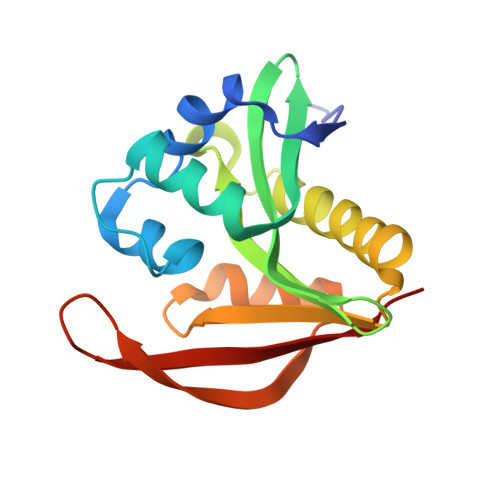Structural, functional, and inhibition studies of a Gcn5-related N-acetyltransferase (GNAT) superfamily protein PA4794: a new C-terminal lysine protein acetyltransferase from pseudomonas aeruginosa.
Majorek, K.A., Kuhn, M.L., Chruszcz, M., Anderson, W.F., Minor, W.(2013) J Biological Chem 288: 30223-30235
- PubMed: 24003232
- DOI: https://doi.org/10.1074/jbc.M113.501353
- Primary Citation of Related Structures:
3PGP, 4KLV, 4KLW, 4KOR, 4KOS, 4KOT, 4KOU, 4KOV, 4KOW, 4KOX, 4KOY, 4KUA, 4KUB, 4L89, 4L8A - PubMed Abstract:
The Gcn5-related N-acetyltransferase (GNAT) superfamily is a large group of evolutionarily related acetyltransferases, with multiple paralogs in organisms from all kingdoms of life. The functionally characterized GNATs have been shown to catalyze the transfer of an acetyl group from acetyl-coenzyme A (Ac-CoA) to the amine of a wide range of substrates, including small molecules and proteins. GNATs are prevalent and implicated in a myriad of aspects of eukaryotic and prokaryotic physiology, but functions of many GNATs remain unknown. In this work, we used a multi-pronged approach of x-ray crystallography and biochemical characterization to elucidate the sequence-structure-function relationship of the GNAT superfamily member PA4794 from Pseudomonas aeruginosa. We determined that PA4794 acetylates the N¦Å amine of a C-terminal lysine residue of a peptide, suggesting it is a protein acetyltransferase specific for a C-terminal lysine of a substrate protein or proteins. Furthermore, we identified a number of molecules, including cephalosporin antibiotics, which are inhibitors of PA4794 and bind in its substrate-binding site. Often, these molecules mimic the conformation of the acetylated peptide product. We have determined structures of PA4794 in the apo-form, in complexes with Ac-CoA, CoA, several antibiotics and other small molecules, and a ternary complex with the products of the reaction: CoA and acetylated peptide. Also, we analyzed PA4794 mutants to identify residues important for substrate binding and catalysis.
Organizational Affiliation:
From the Department of Molecular Physiology and Biological Physics, University of Virginia, Charlottesville, Virginia 22908,; the Bioinformatics Laboratory, Institute of Molecular Biology and Biotechnology, Faculty of Biology, Adam Mickiewicz University, 61-614 Poznan, Poland,; the Midwest Center for Structural Genomics, Argonne National Laboratory, Argonne, Illinois 60439, and; the Center for Structural Genomics of Infectious Diseases (CSGID).
















